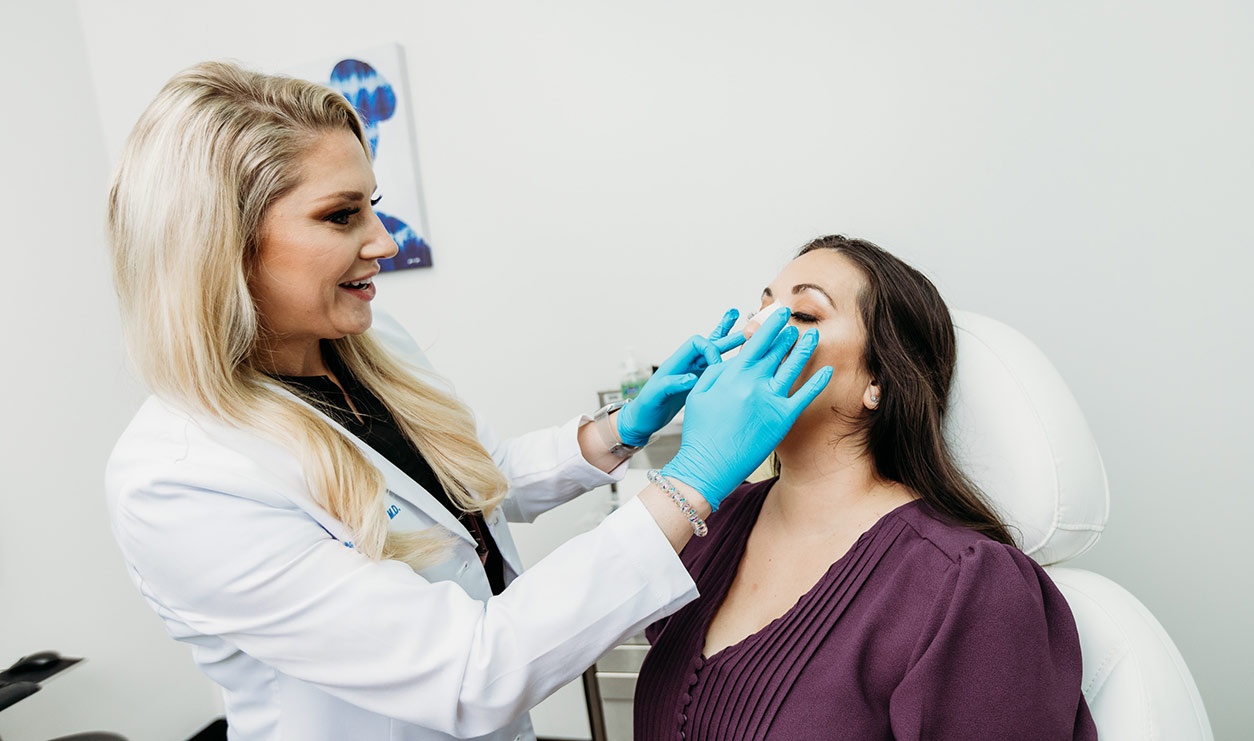
Primary Rhinoplasty in Boca Raton is more than a cosmetic change; it’s a journey toward enhanced facial harmony and improved nasal function. Our expert surgeons specialize in tailoring Rhinoplasty to each individual, ensuring results that are as functional as they are beautiful.

Primary Rhinoplasty, also commonly referred to as a nose job, is a comprehensive procedure aimed at enhancing both the aesthetic appeal and functional aspects of the nasal structure. Performed by skilled board-certified surgeons in Boca Raton, this procedure meticulously reshapes the nose to achieve a more aesthetically pleasing appearance. The process involves advanced surgical techniques, ensuring that patients experience minimal downtime. The primary focus of Dr. Nachlas and Dr. Hancock’s Rhinoplasty procedure is to deliver natural-looking, long-lasting results, blending seamlessly with the patient’s facial features.
The Nose and Sinus Institute of Boca Raton’s nose job procedure is perfect for those seeking aesthetic and functional nasal improvements.
Recovery from Primary Rhinoplasty typically involves a short downtime, with most patients returning to normal activities within a few weeks. Our Boca Raton team ensures a comfortable recovery process, providing detailed care instructions for optimal healing. Typically, patients return to work or school in about one week and are “restaurant ready” within 2 weeks. Our surgeons also recommend that strenuous activity, heavy lifting, and other physical activities be limited for the first 3-6 weeks after surgery. The best nose job results occur if a patient understands the rhinoplasty recovery process.
By choosing to undergo this surgery, you’re not only altering the shape of your nose but also embracing the advantages of having a well-proportioned nose. Other benefits include:
While Primary Rhinoplasty is a highly effective procedure, like any surgical intervention, it comes with certain risks and side effects. Our expert Rhinoplasty surgeons employ advanced techniques and meticulous planning to minimize these risks and side-effects, which may include:
Our widely published, double board-certified surgeons’ commitment to achieving your aesthetic goals is matched by their dedication to maintaining the highest standards of safety and patient satisfaction. Contact our Boca Raton, Florida office to schedule your rhinoplasty consultation.
Conveniently located in Boca Raton, our ENT doctors serve Boca Raton and all surrounding communities in Palm Beach and Broward Counties
During your initial consultation, your surgeon will evaluate your nasal structure, discuss your aesthetic and functional goals, and explain the procedure in detail. They may also use imaging technology to give you an idea of potential outcomes.
Yes, the procedure can realign the nasal bones and reshape the cartilage to improve both the appearance and function of the nose after an injury.
Preparation for Rhinoplasty includes avoiding medications that can increase bleeding, such as aspirin or ibuprofen, for a few weeks before surgery. It’s also important to stop smoking well in advance, as smoking can hinder the healing process.
The procedure is typically recommended for individuals who have completed their facial growth. This usually occurs around age 16 for girls and a bit later for boys. An evaluation by one of our surgeons can determine the right timing.
Primary Rhinoplasty is usually performed under general anesthesia, ensuring that you are asleep and comfortable throughout the procedure. In some cases, local anesthesia with sedation may be used.
Rhinoplasty results are generally permanent, and while the natural aging processes will continue, the changes made to the nasal structure typically last a lifetime.
While the procedure primarily focuses on the appearance and structure of the nose, it can sometimes improve breathing and sinus issues, especially if combined with procedures like Septoplasty or Turbinate Reduction.
The Open Rhinoplasty procedure has advantages for patients with severely deformed noses or significant problems with the tip of the nose. In this approach, Dr. Hancock and Dr. Nachlas can directly sculpt and correct asymmetries in the tip and skeleton of the nose to maximize the structure. The disadvantage of Open Rhinoplasty is that there is a small incision across the bottom of the nose, which, fortunately, heals extremely well and is nearly imperceptible within weeks of the surgery.
Closed Rhinoplasty is done totally within the nose with no external incisions and is particularly applicable in patients who have a fairly symmetrical nose, desire minor corrections to the appearance of the nose, and/or have a nasal tip that is already in correct proportion. This minimally invasive technique has the advantage of quicker healing and less operative time. It is a procedure done entirely inside of the nose, correcting the framework with small incisions through the internal lining.
A Rhinoplasty is used to reshape or resize the nose while a Septoplasty is used to straighten the nasal septum due to a deviated septum. A deviated septum may make it tough to breathe through the nose, and a Septoplasty is commonly used to treat this issue.
A Septoplasty and Rhinoplasty may be performed together under one anesthetic and with one recovery period.
Take charge of your life today! Call us or submit an online form, and you will be speaking with one of our talented surgeons in no time.
(561) 939-7352